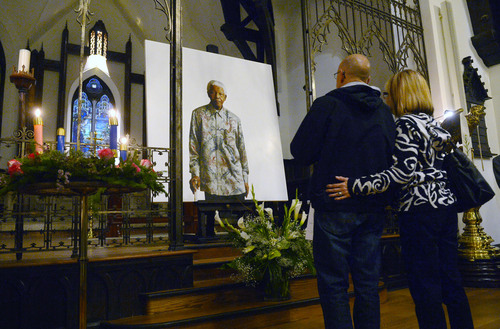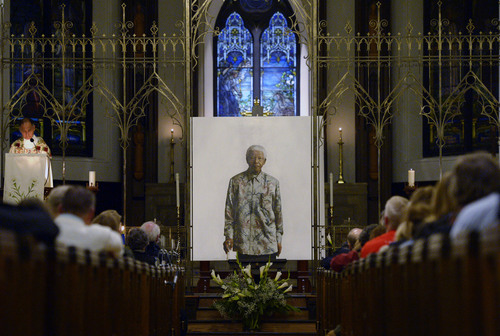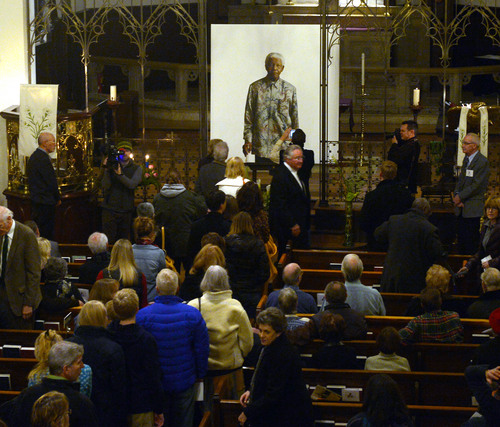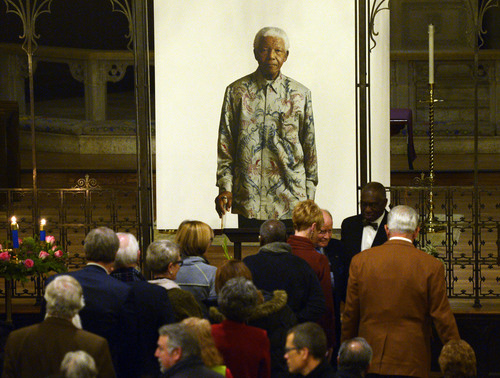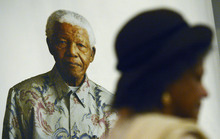This is an archived article that was published on sltrib.com in 2013, and information in the article may be outdated. It is provided only for personal research purposes and may not be reprinted.
Forest Crawford walked around Nelson Mandela's prison cell, a haunting and powerful experience.
"You could stand around and … sense the profound oppression that each of those inmates had to experience," Crawford recalled. That was in 2008, when the Weber State University professor was in South Africa for an education symposium.
The prison, like South Africa, had transformed since Mandela spent 27 years behind its bars, only to become president and help heal his nation.
Crawford intended to fly to the memorial for Mandela, who died Dec. 5, but medical complications prevented the trip. Instead, Crawford attended a service to remember the celebrated humanitarian at The Cathedral Church of St. Mark on Sunday.
An original oil painting of Mandela by artist Robert McCurdy had its first public showing at the service conducted by the Right Rev. Scott B. Hayashi, 11th bishop of the Diocese of Utah; as well as by former Bishop Carolyn Tanner Irish and the Dean of the Cathedral, the Very Rev. Ray Waldon.
Crawford was fifth in a long line to view the painting, so lifelike you almost expected Mandela to blink.
"It looks like a photograph," Waldon remarked.
The service was more a salute and celebration than a solemn affair. The evening rotated between clerics praising Mandela's accomplishments, moments of reflective silence and light, uplifting pieces from a quartet of musicians from the Utah Symphony Orchestra.
"We are here to pay our respects to a man who literally changed the course of history in our lifetime," Waldon said from the pulpit.
Mandela spent almost three decades as a prisoner of apartheid, then emerged to lead a delicate transition to democracy when many South Africans feared the country would sink into all-out racial conflict. He became president in the first all-race elections in 1994, served one five-year term and became a global symbol.
At the service, Jan Abramson remembered living in England in the early 1990s. One day she was talking to a 7-year-old girl named Amy King who had "her big secret" to tell Abramson: Mandela, a rising leader of another nation far from her own, was her hero.
"It brings a smile to my heart," Abramson said.
The news of his death was "expected, but still unwelcome," Tanner said. The man had "offered us understanding. We will not withhold forgiveness, even from those who do not ask."
Carol Bendekovich, who had come to the service to celebrate Mandela's life, admires how he emerged from that prison and was not filled with bitterness. As Hayashi pointed out, Mandela even invited the prison guards to the front row of his inauguration.
The prisoner-turned-president became an international model in how people should elevate human dignity, Crawford said.
Leaving the service, Crawford added that it was "very reverent, very reflective. People were resolved to do better and to be better. That was inherent in the message tonight."
The Associated Press contributed to this story.
Twitter: @mikeypanda


